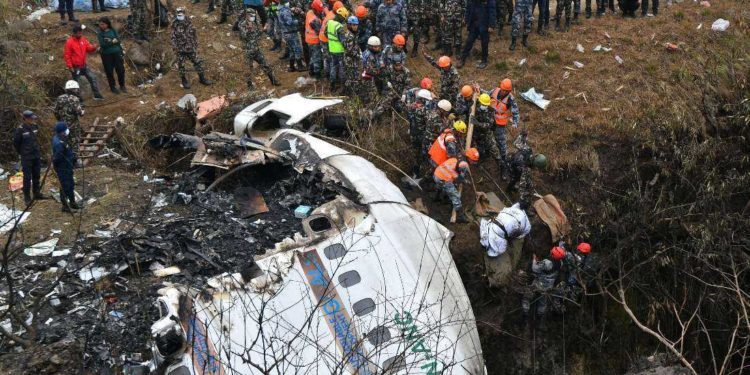Officials said 69 bodies had been recovered so far, with autopsies on 24 ongoing
Rescuers pull the body of a victim who died in a Yeti Airlines plane crash in Pokhara on Jan. 16. (Photo: AFP)
Nepali rescuers suspended late Monday the search for three missing bodies in the mangled wreckage of a plane that crashed with 72 people on board, with no hope of finding survivors.
The Yeti Airlines ATR 72 plummeted into a steep gorge, smashed into pieces, and burst into flames as it approached the central city of Pokhara on Sunday, in Nepal’s worst aviation disaster since 1992.
The cause was not yet known but a video on social media — verified by AFP partner ESN — showed the twin-propeller aircraft banking suddenly and sharply to the left as it neared Pokhara airport. A loud explosion followed.


Nepal, which has a poor record on air safety, observed a day of mourning on Monday. Fifteen foreigners were on board the plane including five Indians, four Russians and two South Koreans.
Soldiers used rope and stretchers to retrieve bodies from the 300-meter (1,000-foot) deep ravine late into the night on Sunday and throughout Monday before suspending their work until Tuesday morning.
Officials said 69 bodies had been recovered so far, with autopsies on 24 ongoing. The plane was carrying 68 passengers and four crew.
“We pray for a miracle. But the hope of finding anyone alive is nil,” senior local official Tek Bahadur KC told AFP.
“Three bodies still missing. Search paused for today. We will resume the search operation tomorrow morning,” he said.
He added that no black box had been found among the debris, which included the mangled remains of passenger seats and the plane’s white fuselage.
‘In pain’
Raj Dhungana, the uncle of one of the passengers, 23-year-old Sangita Shahi, told AFP outside a hospital in Pokhara that his whole family “is in pain”.
He described a “very talented” young woman who was a student in Kathmandu and ran a makeup studio while working on an online business platform on the side.
“God has taken away such a nice person,” he said.
The ATR 72 was flying from the capital Kathmandu to Pokhara, a gateway for religious pilgrims and trekkers.
It hit the ground between the brand-new international airport and an older domestic one shortly before 11:00 am (0515 GMT).
“I was walking when I heard a loud blast, like a bomb went off,” said witness Arun Tamu, 44, who was around 500 meters (yards) away and live-streamed video of the blazing wreckage on social media.
“A few of us rushed to see if we could rescue anybody. I saw at least two women were breathing. The fire was getting very intense and it made it difficult for us to approach closer,” the former soldier told AFP.
It was unclear if anyone on the ground was injured.
Aviation expert Greg Waldron told AFP that from the video shared on social media, it appeared the plane may have suffered a “wing stall”, meaning one wing suddenly stopped providing lift.
“When you’re at low altitude and you have an event like that… it’s major trouble,” Waldron, Asia managing editor at industry publication FlightGlobal, told AFP.
Terence Fan, an aviation expert at the Singapore Management University, said after looking at the same video that it was unclear if the cause was pilot error or a mechanical malfunction.
France-based manufacturer ATR said in a statement on Sunday that its “specialists are fully engaged to support both the investigation and the customer”.
Experts from the French accident investigation agency, the Bureau of Enquiry and Analysis for Civil Aviation Safety, were due to arrive in Nepal on Tuesday, the body said.
Poor record
Nepal’s aviation industry has boomed in recent years, carrying goods and people between hard-to-reach areas, as well as ferrying foreign mountain climbers.
Yeti Airlines, Nepal’s second-biggest carrier, was founded in 1998 by entrepreneur Ang Tshering Sherpa, who died in a helicopter crash in 2019.
The sector has been plagued by poor safety due to insufficient training and maintenance. The European Union has banned all Nepali carriers from its airspace over safety concerns.
Nepal also has some of the world’s most remote and trickiest runways, flanked by snow-capped peaks with difficult approaches and capricious weather.
The country’s deadliest aviation accident took place in 1992, when all 167 people on a Pakistan International Airlines jet died when it crashed on approach to Kathmandu.
Latest News
Credit: Source link




